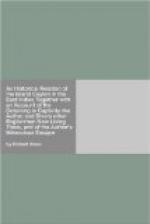[The difference of the Seasons in this Country.] The one part of this Island differs very much from the other, both in respect of the Seasons and the Soyl. For when the Westwardly Winds blow, then it rains on the West side of the Island: and that is the season for them to till their grounds. And at the same time on the East side is very fair and dry weather, and the time of their Harvest. On the contrary, when the East Winds blow, it is Tilling time for those that inhabit the East Parts, and Harvest to those on the West. So that Harvest is here in one part or other all the Year long. These Rains and this dry weather do part themselves about the middle of the Land; as oftentimes I have seen, being on the one side of a Mountain called Cauragas hirg, rainy and wet weather, and as soon as I came on the other, dry, and so exceeding hot, that I could scarcely walk on the ground, being, as the manner there is, barefoot.
[What parts have most Rain.] It rains far more in the High-Lands of Conde Uda, then in the Low-Lands beneath the Hills. The North End of this Island is much subject to dry weather. I have known it for five or six Years together so dry, (having no Rains, and there is no other means of water but that; being but three Springs of running water, that I know, or ever heard of) that they could not plow nor sow, and scarcely could dig Wells deep enough to get water to drink, and when they got it, its tast was brackish. At which time in other Parts there wanted not Rain; Whither the Northern People were forced to come to buy food. Let thus much suffice to have spoken of the Countreys, Soyl and Nature of this Island in general. I will proceed to speak of the Cities and Towns of it, together with some other Remarkable Matters there-unto belonging.
CHAP. II.
Concerning the Chief Cities and Towns of this Island.
[The most Eminent Cities are Five.] In this Island are several Places, where, they say, formerly stood Cities; and still retain the Name, tho little or nothing of Building be now to be seen. But yet there are Five Cities now standing, which are the most Eminent, and where the King hath Palaces and Goods; yet even these, all of them, except that wherein his Person is, are ruined and fallen to decay.




